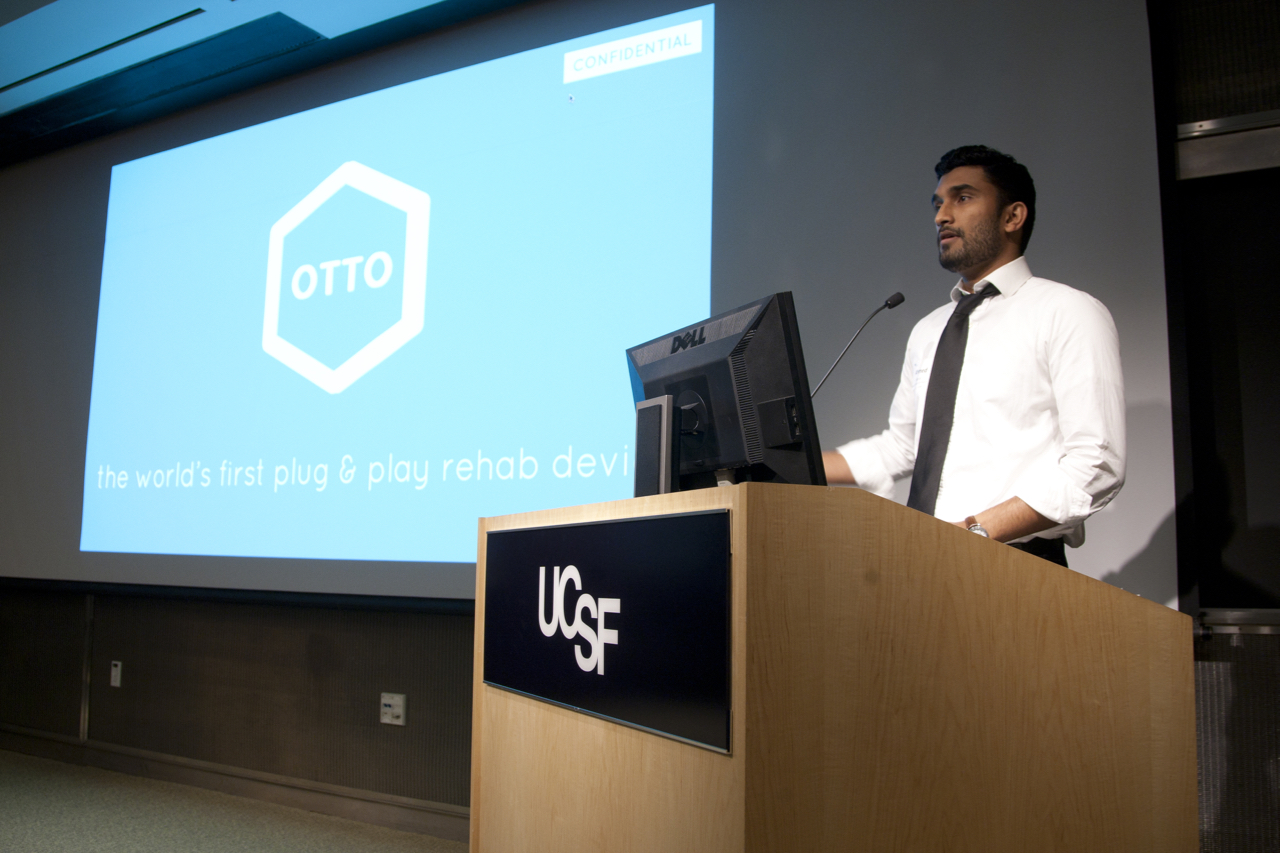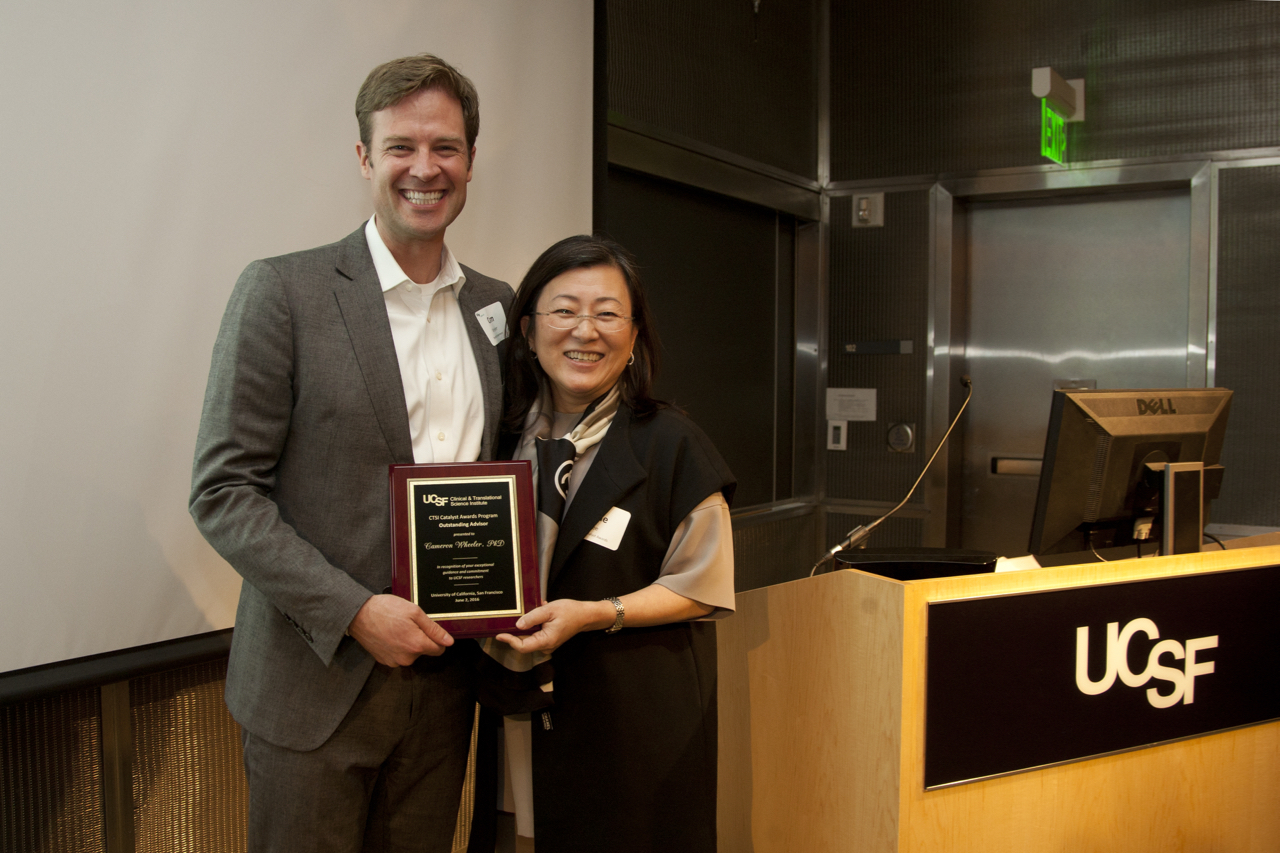
Catalyst Program Pairs UCSF Scientists With Expert Advisors to Advance Innovation
By Dan Fost
A scientist may be absolutely brilliant in dissecting a molecular pathway, or figuring out the roots of a disease. Yet that same scientist may know very little about how to bring the outcomes of his or her research to the market as a drug or device—how to evaluate the market opportunity, raise money, form a company, and protect intellectual property, among many other potential hurdles.
Enter the UCSF Catalyst Awards program, which matches the university’s scientific investigators with industry advisors and provides seed funds to help them take those crucial steps toward bringing their discoveries to the patients who need them.
The advisors are the lifeblood of what we do.
At the program’s spring 2016 report-out in Genentech Hall in early June, many scientists paid tribute to the advisors who helped guide their investigations.
Adam Renslo, PhD, an associate professor of pharmaceutical chemistry, acknowledged advisors John Jacobsen, PhD, and Gary Patou, MD, as he worked on finding compounds to attack carbapenemases that cause some bacteria to become resistant to antibiotics. “John and Gary were really helpful in getting us to focus,” Renslo said.

June Lee, MD, Catalyst director
Jacobsen, the vice president of chemistry at the biotech company DiCE Molecules, said Renslo is working in “an area of significant unmet need.” “There’s been a failure of the pharmaceutical industry to identify a new class of drugs” to tackle these new breeds of drug-resistant bacteria, Jacobsen said. “For the past 40 years, they’ve been working on derivatives of previous drugs, which is important, but there’s been very little that’s new.”
Renslo, who won a Catalyst award at the event, is looking at novel ways of inhibiting those drug-resistant pathogens, Jacobsen said. Renslo is thinking big; “the Holy Grail,” he said, “would be a beta-lactamase inhibitor that has broad bacteria infection coverage.”
Honoring the Advisors
Jacobsen was one of two advisors honored at the event, along with Cameron Wheeler, PhD, a principal on the private transactions team at Deerfield Management, a health care investing firm. June Lee, MD, director of the Catalyst program at the UCSF Clinical and Translational Science Institute (CTSI), praised the honorees. “They bring a lot of incredible expertise to the conversation,” she said.

June Lee, MD, Catalyst director
Wheeler received a shout-out from the stage from Corey Raffel, PhD, MD, a UCSF professor of neurological surgery, who is working with a colleague from the University of Washington to see if they can use the measles virus to combat certain types of cancer tumors.
Wheeler connected with Raffel in the consultation phase of the Catalyst program in which Catalyst plays matchmaker, connecting scientists with appropriate mentors for the project and its development stage. The academic investigators gain a lot of highly valuable advice on their project, but what motivates the advisors to spend their time on supporting UCSF projects?
“It’s a fantastic experience—having the ability to interact with great academics who are doing really interesting research,” Wheeler said. “I’ve looked at a number of companies, I know the competitive landscape, and I have an idea of what you actually need to show to be able to secure investment. It’s not the academics’ job to know about the competitive landscape and these other commercialization-related aspects.”
It was a good match, Wheeler said: Wheeler is not an expert in glioblastoma, or brain tumors, as Raffel is, but Raffel needed Wheeler’s help in refining his presentation to focus on “what he’s trying to solve, what he’s asking for in his grant, and making that attractive for future investors.”
In many respects, that’s the secret sauce of the Catalyst program. “The advisors are the lifeblood of what we do,” said Cathy Tralau-Stewart, PhD, associate director and head of the Catalyst program’s therapeutics track. “Some of them put in such a time commitment! They also benefit from keeping in touch with innovative basic research, networking with our investigators, or spotting potential investment opportunities. They enjoy giving back to the research community where many have been trained.”
Catalyst has more than 200 advisors, some with more business expertise, and some with more of a scientific background. “Pairing is important,” Tralau-Stewart said. “We have to find the right advisors for the right project, and with the size of our panel we are often able to find the perfect match between the technology and advisor expertise.”
Building Businesses
Ed Hurwitz, JD, MBA, managing director at Precision BioVentures, LLC, who won the Catalyst Outstanding Advisor award at the report-out in January, said the program had paired him in the past with Jason Gestwicki, PhD, a UCSF associate professor. Gestwicki won a Catalyst award in 2013 for his work on cataracts, which began when he was at the University of Michigan. That work, and the Catalyst advisor network, led him to found ViewPoint Therapeutics, Inc., in 2014.
ViewPoint—for which Hurwitz now serves as chairman of the board—received $4 million in venture capital in May to help develop a topical therapy for resolving cataracts.
“It looked to me like a tremendous opportunity that could lead to the management of a disease that’s now treated only by surgery,” Hurwitz said. “We hope to provide a pharmaceutical alternative that should be more convenient and probably cheaper. It also has the potential to benefit hundreds of millions of people in the developing world who don’t have access to surgery, and it has the promise of prevention.”
While Gestwicki and others bring dazzling scientific knowledge, Hurwitz’s role “is largely to provide strategic advice, introductions to my network of people with commercial experience in the industry, building and recruiting the team, and raising the money.”
Hurwitz also helped secure the licenses to Gestwicki’s patents from the academic institution where it was developed he said. “There are a lot of little things you have to do to form a company.”
Inspiring Science
Much of the science at the recent Catalyst event was similarly inspiring. Renslo and Raffel presented in the therapeutics track; another presenter, Paul Marinec, PhD, a postdoctoral fellow in the lab of Jim Wells, PhD, a professor of pharmaceutical chemistry, gave a polished presentation in which he put the fight against cancer into starkly personal terms. “One in three Americans will develop some form of cancer, often by age 65,” he said, showing photographs of loved ones he lost to cancer. His contribution to that battle: to develop antibodies able to recognize only the mutated RAS protein in RAS-driven tumor cells. The RAS oncoprotein drives one-third of all cancers, he said, and his work is showing “promising in vitro results.” “We want to see if it will work in vivo,” he said. “If we can get that data, we feel we’ll be at an inflection point for our technology.”
The report-out also showcased projects in devices and in digital health.
In devices, presenters included Ying Han, MD, PhD, who is developing a mesh-like device that can integrate well with eye tissues without causing fibrosis for treatment of glaucoma, which she called “the leading cause of irreversible blindness in the world.” Han and her collaborator, Chong Xie, PhD, at University of Texas Austin, showed pilot in vivo data that supported their hypothesis. Their advisors, Sean Ianchulev, MD, MPH, and Charles Semba, MD, helped the team finalize the product concept and explore the regulatory and clinical development pathway.
Caroline Jordan, PhD, a postdoc in the lab of Steven Hetts, MD, associate professor in the Department of Radiology, is working on a novel catheter that is visible under MRI and enables MR-guided intervention. Kurtis Auguste, MD, a pediatric neurosurgeon, is working on a new shunt to treat hydrocephalus, “which causes accumulation of fluid in the brain.” Stanley Rogers, MD, and his team are developing a device to help anesthesiologists to better assess the risk of aspiration in surgical patients.
Three digital health presenters showed the promise of using everyday technology to tackle vexing problems. Ma Somsouk, MD, MAS, has developed a dashboard that can help in training medical professionals, simply and quickly showing both trainers and trainees “what’s been done, what needs improvement, and how they compare to their peers.” Ahmed Rahim, a graduate student, is working on rehabilitation devices for post-stroke motor recovery. He’s called his device “Otto,” and claims he can cut the productivity lost by stroke survivors in half by improving on the current standard of care—physical therapy that’s limited in duration. “I don’t consider physical therapy direct competition, because the therapists are so over-stretched,” he said in the question-and-answer period following his presentation. “I want to alleviate their workload and allow patients and their families to take charge of their rehabilitation at home, having the appropriate tools.”
Giving Babies Breath
Holly Martin, MD, an assistant professor of pediatrics, showed her concept for BREATH, which loosely stands for “Baby Resuscitation Enhanced—A Tech Solution.” She said a shocking number of newborns enter the world in distress; one million die on their first day of life. Of the 140 million babies born worldwide each year, 10 percent can’t breathe, and need immediate resuscitation.
Yet despite all the technological advances, doctors still rely on the stethoscope or a hand feeling the baby’s pulse, she said. “My solution is a combination of hardware and software—a heart rate sensor paired with a resuscitation algorithm on a smartphone. We can guide healthcare workers in real time through the proven steps of saving a baby.”
If the baby isn’t breathing, the app offers “corrective steps if what you’re doing isn’t working,” Martin said. She’s already conducted a randomized controlled trial in Peru, and reported the results were “fantastic.”
Martin was among the award winners at the event.
“I have no technology background,” Martin said in an interview. What she had was clinical expertise; she saw the babies struggling. “It was one of those ‘aha’ moments. I sketched out the concept on a piece of paper.”
But she needed help to turn it into reality. Martin’s advisors, Ravi Srinivasan, PhD and Sanjay Shah, MBA, helped her think through a viable business model for a technology that is applicable in both high and low resource settings. “Without Catalyst, I wouldn’t have been able to make the connections and get the expertise I needed,” Martin said. “It’s thrilling to me to get the help to make something real.”
Spring 2016 Catalyst Award winners
- Adam Renslo, PhD, Optimization and Biological Characterization of Novel Carbapenemase Inhibitors
- Caroline Jordan, PhD, Micro Resonant Marker: A Novel Device for Catheter Visualization during Interventional MRI
- Corey Raffel, PhD, MD, A Targeted Oncolytic Measles Virus for the Treatment of Many Tumor Types
- Holly Martin, MD, Mobile Health Solution for Improved Neonatal Resuscitation: BREATH
- Pierre Theodore, MD, Otto: Digital Rehabilitation Device for Post-Stroke Motor Recovery
- Sunghoon Kim, MD, A Novel Shunt for the Treatment of Hydrocephalus
- Ying Han, PhD, MD, A Novel Drainage Device to Reduce Fibrosis in Glaucoma Surgery

